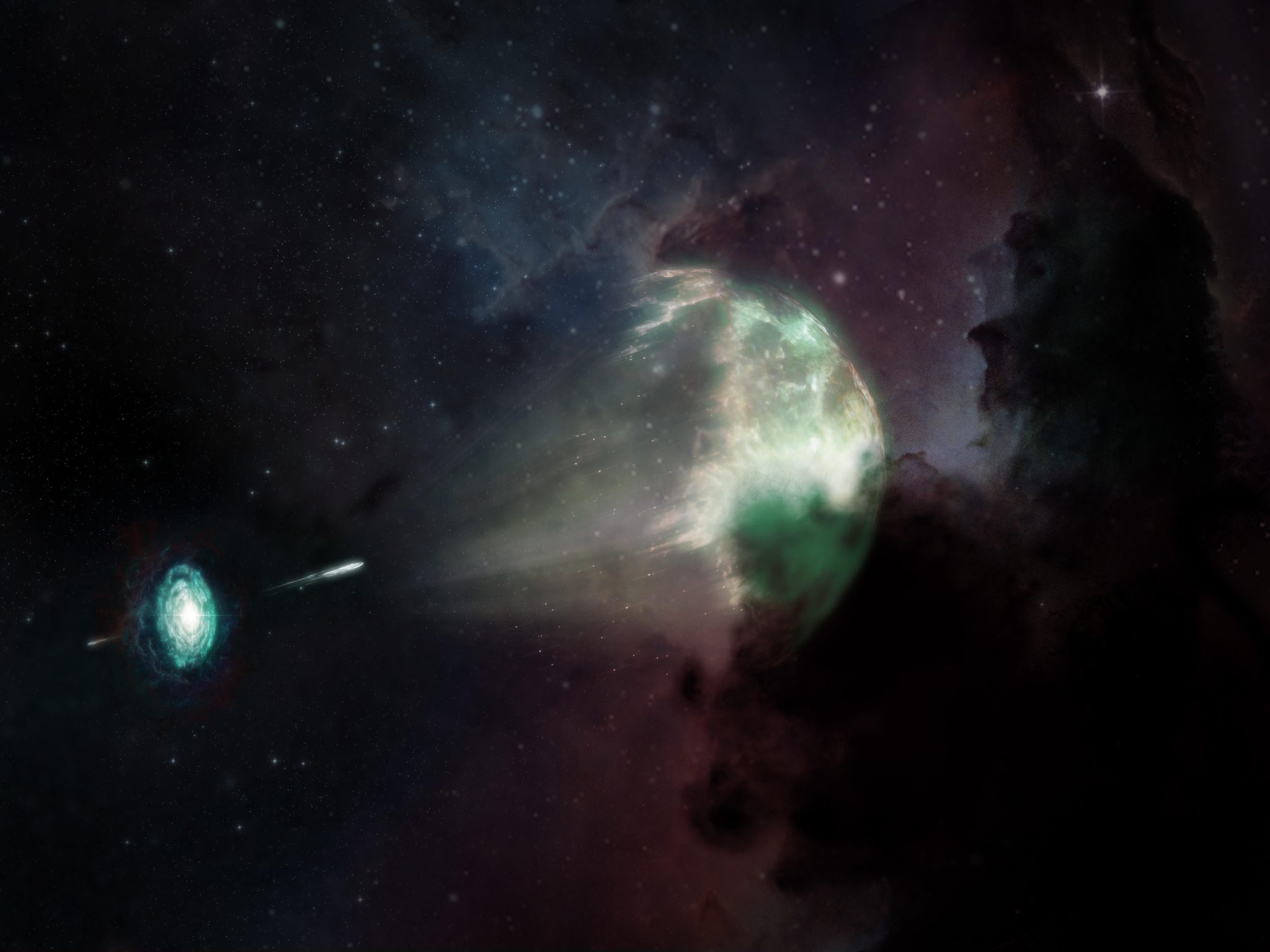
I en første for radioastronomi har forskere oppdaget millimeterbølgelengdelys fra et kortvarig gammastråleutbrudd. Denne kunstnerens oppfatning viser sammenslåingen mellom en nøytronstjerne og en annen stjerne (sett som en skive, nede til venstre) som forårsaket en eksplosjon som resulterte i det kortvarige gammastråleutbruddet, GRB 211106A (hvit stråle, midten), og etterlot det som forskere vet nå å være en av de mest lysende etterglødene som er registrert (halvsfærisk sjokkbølge midt til høyre). Mens støv i vertsgalaksen skjulte det meste av det synlige lyset (vist som farger), var millimeterlys fra hendelsen (avbildet i grønt) i stand til å unnslippe og nå Atacama Large Millimeter/submillimeter Array (ALMA), noe som ga forskere en enestående utsikt av denne kosmiske eksplosjonen. Fra studien bekreftet teamet at GRB 211106A er en av de mest energiske kortvarige GRB-ene som noen gang er observert. Kreditt: ALMA (ESO/NAOJ/NRAO), M. Weiss (NRAO/AUI/NSF)
Blitsen er en av de mest energiske kortvarige gammastråleutbruddene som noen gang er observert.
For første gang har forskere fanget lys på millimeterbølgelengde fra en intens eksplosjon forårsaket av sammenslåingen av en[{” attribute=””>neutron star and another star using the Atacama Large Millimeter/submillimeter Array (ALMA), an international observatory operated by the US National Science Foundation’s National Radio Astronomy Observatory (NRAO).
The scientists also determined that this burst of light was one of the most powerful short-duration gamma-ray bursts ever observed, producing one of the most luminous afterglows ever recorded. The findings were recently published in The Astrophysical Journal Letters.
The brightest and most energetic explosions in the universe, gamma-ray bursts (GRBs), may produce more energy in a few seconds than our Sun will produce in its entire lifetime. GRB 211106A belongs to a GRB subclass called short-duration gamma-ray bursts. The catastrophic merging of binary star systems containing neutron stars leads to these explosions, which are thought to be the source of the heaviest metals in the Universe, such as platinum and gold.
I tidenes første time-lapse-film av et kortvarig gammastråleutbrudd i millimeterbølgelengdelys, ser vi GRB 21106A som fanget med Atacama Large Millimeter/submillimeter Array ([{” attribute=””>ALMA). The millimeter light seen here pinpoints the location of the event to a distant host galaxy in images captured using the
A short-duration GRB usually lasts only a few tenths of a second. Scientists then look for an afterglow, an emission of light caused by the interaction of the jets with the surrounding gas. Even still, they’re difficult to detect; only half-a-dozen short-duration GRBs have been detected at radio wavelengths, and until now none had been detected in millimeter wavelengths. Laskar, who led the research while an Excellence Fellow at Radboud University in The Netherlands, said that the difficulty is the immense distance to GRBs, and the technological capabilities of telescopes.
“Short-duration GRB afterglows are very luminous and energetic. But these explosions take place in distant galaxies which means the light from them can be quite faint for our telescopes on Earth. Before ALMA, millimeter telescopes were not sensitive enough to detect these afterglows.”
At roughly 20 billion light-years from Earth, GRB 211106A is no exception. The light from this short-duration gamma-ray burst was so faint that while early X-ray observations with
Each wavelength added a new dimension to scientists’ understanding of the GRB, and millimeter, in particular, was critical to uncovering the truth about the burst. “The Hubble observations revealed an unchanging field of galaxies. ALMA’s unparalleled sensitivity allowed us to pinpoint the location of the GRB in that field with more precision, and it turned out to be in another faint galaxy, which is further away. That, in turn, means that this short-duration gamma-ray burst is even more powerful than we first thought, making it one of the most luminous and energetic on record,” said Laskar.
Wen-fai Fong, an Assistant Professor of Physics and Astronomy at Harvard University.
“In the case of GRB 211106A, we used some of the most powerful telescopes available— ALMA, the National Science Foundation’s Karl G. Jansky Very Large Array (VLA), NASA’s Chandra X-ray Observatory, and the Hubble Space Telescope. With the now-operational DOI: 10.3847/2041-8213/ac8421